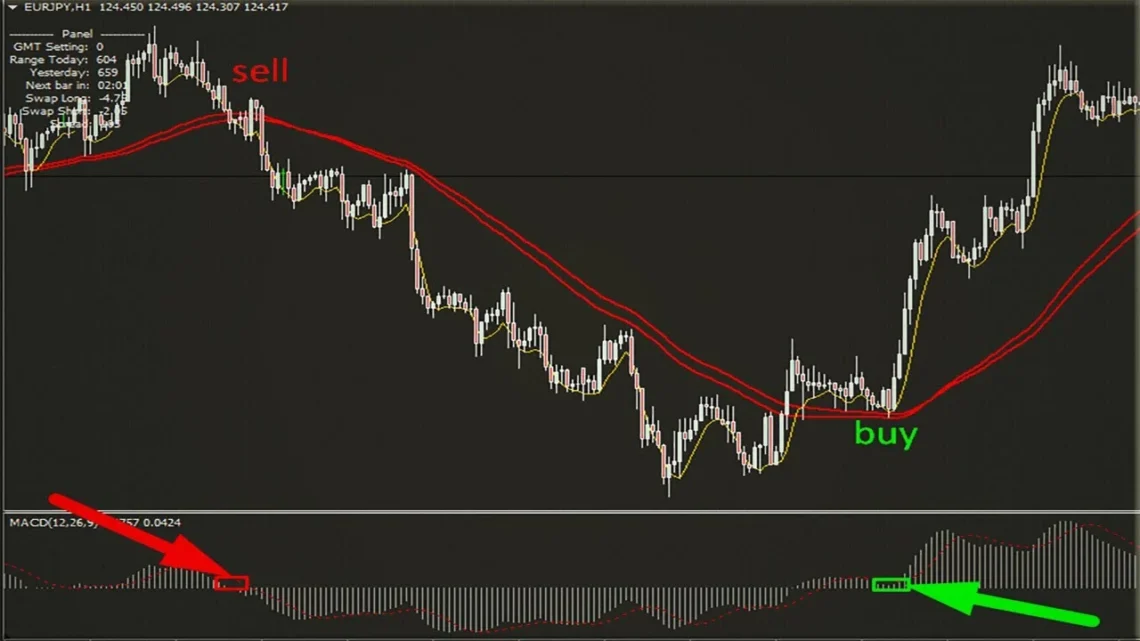Trading in fast-moving markets can feel overwhelming. Many traders struggle to find reliable tools for quick decisions, especially with short-term trades. Using the wrong settings or indicators often leads to missed opportunities or costly mistakes.
The MACD (Moving Average Convergence Divergence) is a popular tool among traders. It helps detect trends and momentum changes in markets. However, its standard settings were not designed for high-frequency scalping strategies.
This blog will guide you on how to adjust MACD settings for faster trades. You will also learn tips to improve accuracy and avoid common errors. Keep reading to sharpen your trading approach!
Understanding MACD for High-Frequency Scalping
The MACD helps traders spot buy and sell opportunities in fast-moving markets. It measures the momentum and direction of price changes on short timeframes.
Key Components of MACD
MACD is built on three key components: the fast-moving average, the slow-moving average, and the signal line. The fast EMA reacts quickly to price changes, while the slow EMA moves more gradually to show overall trends.
Their difference forms the MACD line.
The signal line uses a 9-period EMA of the MACD line to identify potential trade signals. Traders often look for crossover signals between the MACD line and signal line that suggest bullish or bearish momentum.
The histogram visually shows this difference, making it easier to spot shifts in market direction.
MACD breaks down intricate price action into straightforward momentum trends.
Importance of Scalping Strategies in High-Frequency Trading
Scalping strategies are essential in high-frequency trading. These methods focus on capturing small price movements within seconds or minutes, making them suitable for short-term trading.
Traders depend on quick decision-making and accurate technical indicators like the Moving Average Convergence Divergence (MACD) to determine timely entry signals and exit points.
High-frequency traders gain advantages from scalping by increasing profits through numerous rapid trades throughout the day. This approach limits exposure to market risks caused by sudden volatility.
Scalping strategies require discipline, strict risk management, and a thorough understanding of momentum trading patterns to succeed in this fast-paced setting.
Default MACD Settings
The default MACD settings are widely used in trading for general analysis. These standard parameters may not align well with the fast pace of scalping strategies.
Explanation of Standard Settings (12, 26, 9)
The standard MACD settings use 12, 26, and 9 as default parameters. The number 12 represents the fast Exponential Moving Average (EMA), which reacts quickly to price changes. The number 26 is the slow EMA, smoothing out longer-term trends for better clarity.
Lastly, the number 9 defines the signal line, which averages MACD values over nine periods to detect potential momentum shifts.
These three numbers form a foundational setup for identifying entry signals in various trading strategies.
This configuration works well for general market analysis but may lag in high-frequency scalping strategies. Traders often find it less responsive for shorter timeframes like one-minute or five-minute charts due to its slower reaction during rapid price movements.
Limitations of Default Settings for Scalping
Default MACD settings of (12, 26, 9) are more suitable for longer timeframes. Scalping depends on quick trades within minutes. These standard settings often respond too slowly and fail to capture rapid price movements in high-frequency trading.
Short-term volatility makes default signal lines less reactive. This slower response can lead to missed entry or exit points during scalping strategies. Relying on fixed numbers may also overlook changing market conditions across different sessions.
Customizing MACD Settings for Scalping
Traders can adjust MACD to better suit short-term scalping needs by experimenting with macd scalping settings that emphasize speed and responsiveness. Modify parameters to match specific timeframes and trading conditions.
Adjustments for Short Timeframes (1-Minute and 5-Minute Charts)
Short timeframes require specific adjustments for better accuracy. Altering MACD settings assists traders in identifying precise entry and exit points during scalping.
- Decrease the fast EMA period to 6 or 8 to make it more responsive for quick trades. This adjustment captures short-term price movements effectively.
- Adjust the slow EMA period to 13 or 15 to align with rapid market changes. A shorter setting reduces delayed signals in high-volatility conditions.
- Shorten the signal line period to 3 or 5 for quicker crossovers. This modification improves momentum tracking on fast-moving charts.
- Apply these adjusted settings consistently before switching between 1-minute and 5-minute charts. Consistency ensures smoother decision-making processes during scalping sessions.
- Test the modified settings with historical data from different markets before trading live. Testing builds confidence and improves strategy reliability under various conditions.
- Use tight stop-loss orders since short timeframes involve higher risks from unpredictable volatility spikes. Proper risk management limits losses during fast market reversals.
- Closely monitor MACD histogram differences after applying adjusted settings, as they provide early trend direction signals on smaller intervals.
- Reevaluate your setup regularly if new market patterns arise due to shifting liquidity levels or trading hours changes in specific assets.
Adapting Settings for Market Volatility
Market volatility shifts swiftly, impacting trading indicators like MACD. To adjust, shorten the signal line length for quicker responses to rapid price changes during scalping. For example, consider reducing settings such as 12-26-9 to 6-13-4 on high-volatility days.
Refining MACD during volatile markets enables traders to recognize momentum early. Smaller exponential moving average (EMA) values smooth out data while staying responsive. This ensures improved entry signals without lagging behind sudden price action.
Apply these adjustments smoothly into different timeframes in short-term charts.
Optimal MACD Settings for Scalping
Traders can fine-tune MACD settings to match the fast pace of scalping. Adjusting parameters helps maximize accuracy for short-term trades.
Recommended Settings for 1-Minute Charts
Set the MACD to a quicker combination of 6, 13, and 5 for 1-minute charts. This adjustment enables faster response to minor price movements in high-frequency scalping.
Reduce the signal line length to enhance timing for swift trade entries. Apply these settings during times of high activity or significant trends for improved momentum trading indications.
Recommended Settings for 5-Minute Charts
For 5-minute charts, set the MACD’s fast EMA to 8 and the slow EMA to 16. Adjust the signal line to a shorter length, such as 5. These settings create quicker signals for high-frequency scalping.
Shorter timeframes benefit from tighter parameters that follow price action closely. The quicker response helps traders pinpoint accurate entry and exit points during rapid market movements.
Experimenting with Unconventional Settings
Traders often find opportunities by trying unconventional MACD settings. Shortening the fast EMA to 5 and slow EMA to 13 can generate quicker signals for highly volatile markets. This setup aligns better with rapid price-action shifts seen in scalping strategies.
Some traders prefer a signal line of 3 instead of 9 for faster confirmation. Lowering these parameters improves responsiveness but may increase false signals during choppy market conditions.
Testing different combinations on demo accounts can help refine preferences without risking capital.
Combining MACD with Other Indicators for Scalping
Combine MACD with additional indicators to refine your scalping strategy. Align multiple tools for clearer and stronger entry signals.
Using MACD with Moving Averages
Traders use Moving Averages (MA) with MACD to confirm trends and refine entry signals. Adding an Exponential Moving Average (EMA) alongside the MACD helps identify momentum shifts in high-frequency scalping strategies.
For example, a 20-period EMA can emphasize short-term price movements on 1-minute or 5-minute charts.
Aligning a crossover of the MACD line with price action crossing above or below the Moving Average enhances trade confirmation. Combining these indicators decreases false signals during volatile market conditions, improving trade accuracy.
Pairing MACD with Volume Indicators
Pair MACD with volume indicators to confirm the strength of momentum during scalping. Higher trading volumes often validate MACD crossover signals, indicating stronger potential price moves.
For instance, a bullish MACD crossover paired with rising volume suggests increased buying pressure.
Monitor divergence between price and volume for additional insights. A weakening trend may appear if prices rise while volumes drop, even as MACD shows bullish movement. Use tools like the On-Balance Volume (OBV) or Volume Weighted Average Price (VWAP) alongside MACD for more effective short-term trading decisions.
Integrating MACD with Fibonacci Retracement
Combining MACD with Fibonacci Retracement can refine scalping strategies. Use the retracement levels to identify potential support and resistance zones. Apply MACD to confirm momentum before entering trades near these levels.
Set precise retracement ratios, such as 61.8% or 38.2%, for key areas of interest. Look for a bullish crossover on the MACD around a support level, signaling entry opportunities during pullbacks.
In contrast, use bearish crossovers near resistance zones for sell signals in short-term trading setups.
Avoiding Common Mistakes with MACD in Scalping
Avoid misjudging signals by refining settings to match specific trading conditions.
Overly Sensitive Settings
Overly sensitive MACD settings can generate excessive signals. These false alarms often occur when the signal line and histogram react to minimal price changes. This behavior creates noise that may confuse traders during high-frequency scalping.
Shorter periods, such as 5-12 for the fast EMA or 3-9 for the signal line, heighten this sensitivity. Increased choppiness makes distinguishing genuine trends harder. Adjusting settings helps reduce noise while maintaining reliable momentum indicators.
Modifying MACD properly ensures practical adjustments fit market-specific conditions, leading into Ignoring Market-Specific Adjustments next.
Ignoring Market-Specific Adjustments
Traders often overcompensate with sensitive settings but fail to adjust MACD configurations to specific market conditions. Different markets, such as Forex and cryptocurrencies, have distinct volatility patterns.
Ignoring these differences results in inaccurate signals in scalping strategies. A high-volatility environment might need shorter signal lines or quicker EMAs for timely entries. On the other hand, low volatility could call for slightly extended periods for balanced trades.
Modifying your MACD settings ensures improved alignment with the asset’s behavior and time frame efficiency.
Relying Solely on MACD for Decisions
Solely using MACD for scalping decisions can lead to poor outcomes. MACD may lag in fast-moving markets, causing delays in identifying momentum shifts. This delay increases the risk of entering trades too late or missing profitable opportunities.
Combining MACD with other trading indicators improves accuracy. Pair it with volume analysis or Fibonacci retracements to confirm entry signals. Using multiple tools reduces false signals and helps adjust to changing market conditions efficiently.
Benefits of Custom MACD Settings for Scalping
Custom MACD settings help traders focus on precise market movements. They allow better adjustment to rapidly changing price actions.
Improved Signal Accuracy
Adjusting MACD settings improves signal accuracy for scalping. Lower the fast EMA period to 6 or 8 and reduce the slow EMA period to 13 or 21 for quicker responses. Shortening the signal line, such as setting it to 3, can assist in identifying momentum shifts in volatile short-term trading.
These adjustments minimize lag when identifying crossover signals. Traders using one-minute or five-minute charts gain clearer entry points with reduced delay. This contributes to more accurate signals during rapid price action changes common in high-frequency strategies.
Enhanced Trade Timing
Improved signal accuracy directly affects trade timing, particularly in high-frequency scalping strategies. Precise MACD settings enable traders to enter and exit positions at ideal moments during rapid market changes.
Shorter timeframes, such as 1-minute or 5-minute charts, gain from adjusted MACD parameters. Faster crossovers aid in identifying momentum early without delays. These adjustments minimize missed opportunities and enhance overall trade execution in fast-moving environments like high-frequency trading.
Drawbacks and Limitations of MACD in Scalping
MACD often reacts slowly to rapid price changes. Traders may face challenges during volatile market conditions.
Lagging Nature of MACD
The Moving Average Convergence Divergence (MACD) often lags because it relies on historical price data. This delay can make it slow to respond during rapid market movements, which is common in high-frequency scalping strategies.
Traders may notice missed opportunities when the indicator signals an entry or exit after a price reversal has already occurred.
Short timeframes intensify this lag since price changes happen quickly. Modifying MACD settings for shorter signal lines or faster exponential moving averages (EMAs) helps reduce delays but might increase false signals.
Achieving a balance between speed and accuracy requires careful adjustment based on market conditions and trading style.
Potential Over-Optimization
Traders risk making settings too sensitive when they adjust MACD for high-frequency scalping strategies. Over-adjustment can generate excessive signals, leading to false entries and exits in fast-moving markets.
Changing timeframes or signal lengths without proper backtesting may harm performance instead of improving it.
Too much emphasis on tweaking parameters may ignore real market conditions like volatility or liquidity changes. Emphasizing consistency across market trends will help traders identify reliable patterns instead.
Moving forward, understanding the lagging nature of MACD is crucial for effective use in scalping strategies.
Conclusion
Customizing MACD settings can refine scalping results. Modify the indicator to suit shorter timeframes and market conditions. Combining it with other tools increases precision. Avoid excessive adjustments or depending solely on one signal for trades.
Thoughtful changes result in improved timing and greater effectiveness in high-frequency strategies.





